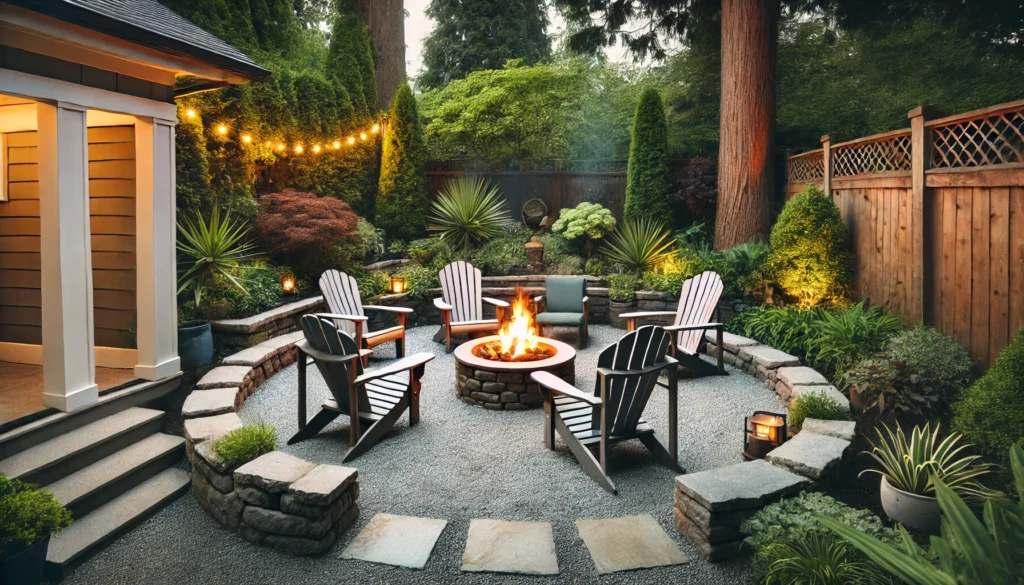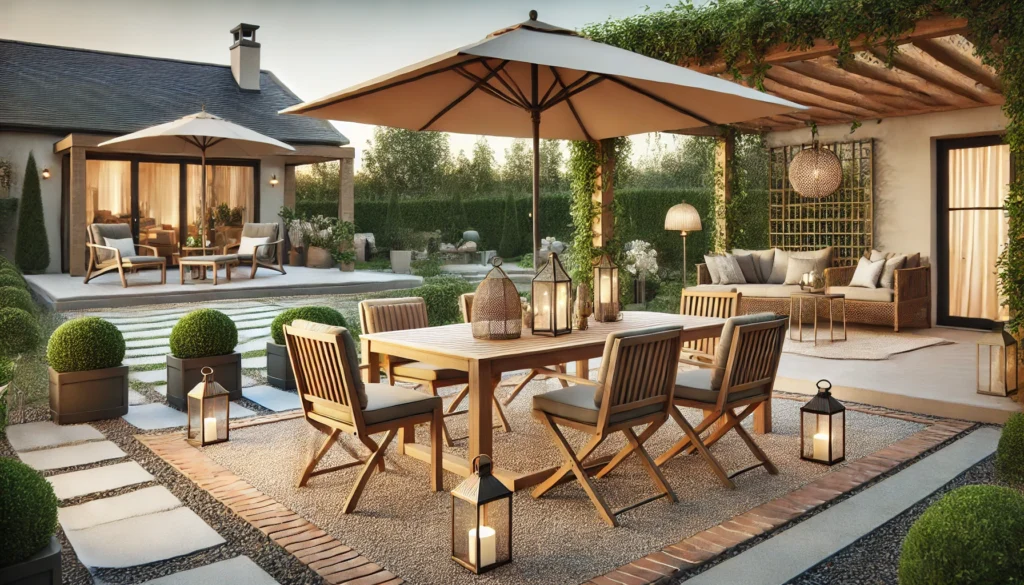Gravel patios offer a budget-friendly, versatile outdoor space. Learn the key advantages and drawbacks before making a decision.
Gravel crunches underfoot in backyards across town, a sound that’s become part of weekend BBQs and lazy summer evenings. These patios won’t break the bank – most folks spend about $5-7 per square foot to get one installed.
Sure, the stones scatter a bit after a good rain or when the kids get rowdy, and you’ll need to rake them back in place now and then. Weeds still sneak through (they always do), but good landscape fabric keeps most of them out. For what you pay though? It’s hard to find a better deal for outdoor living. (1)
Key Takeaways
- Installation & Budget: $5-7 per square foot, DIY-friendly, needs yearly top-ups of fresh gravel
- Stability & Use: Great for drainage, might need stabilizer grids for furniture legs and high-traffic paths
- Design Elements: Works with any garden style, requires 4-inch metal or stone borders, depth should hit 2-3 inches
Cost & Affordability
Credits: Niall Gardens
A gravel patio might not win any fancy design awards, but it’ll save enough cash for a new grill and patio set. Most suppliers charge between $1-3 per square foot for gravel – compare that to concrete’s $6-15 or those fancy pavers running upwards of $30, and you’ve got yourself a deal.
The best part? You won’t need to hire anyone. Grab a few buddies, some cold drinks, and make a weekend of it. Sure beats paying someone else to do the work, especially since gravel doesn’t need special equipment or years of experience to get right. Just some basic tools from the garage and a strong back.
Down the road, gravel keeps the wallet happy too. No cracks to patch like concrete, no sealing like pavers need. When spots start looking thin after a few seasons, just dump in some fresh gravel. Simple fixes for simple problems.
Installation & Maintenance
Getting a gravel patio set up isn’t rocket science. Level the ground (yeah, it needs to be pretty flat), lay down that black fabric stuff to keep weeds at bay, dump in some crushed stone for a solid base, then top it with the good-looking gravel. Don’t forget edges – without something to hold it in, that gravel’s gonna wander.
Taking care of it’s even easier. Rake it when it looks uneven, maybe pick out leaves after a storm. Some weeds’ll probably sneak through – they always do – but they’re easy enough to pull. The fabric underneath means you won’t be fighting a losing battle against nature.
Nobody’s spending weekends sealing it like a wood deck, or calling contractors about winter crack repairs like with concrete. It just sits there, doing its job, needing nothing but a quick rake now and then. That’s the kind of low-maintenance that makes sense for folks who’d rather be grilling than doing yard work.
Design Versatility
Gravel patios (2) pack more style options than most folks realize. Walk into any stone yard and you’ll find heaps of choices – each one giving off its own vibe. Pea gravel’s the crowd favorite, those little rounded stones that come in earthy browns and grays. Crushed granite’s got more bite to it, stays put better too. River rock brings that natural creek-bed look, while marble chips catch the sun and light up the yard like nobody’s business.
Mix and match is the name of the game here. Throw down some stepping stones through the middle, edge it with brick, maybe add a paver path leading up to it. The stuff plays nice with pretty much everything – pergolas, fire pits, those fancy water features everyone’s putting in these days. And garden beds? They look right at home nestled up against the stone.
Drainage & Sustainability
When it comes to handling rain, gravel’s got other patio materials beat hands down. While concrete turns your yard into a pond and pavers start looking like a water park, gravel just lets that water sink right through. No more puddles, no more mud – just natural drainage doing its thing.
The green crowd’s got good reason to love gravel too. Here’s what makes it earth-friendly:
- Rainwater seeps back into the ground instead of running off
- Helps keep soil where it belongs instead of washing away
- No need for chemical sealers or treatments
- Can even use recycled stuff – crushed up concrete works fine
Perfect fit for those water-smart yards with native plants and drought-tough ground covers. It’s the kind of setup that keeps both your water bill and your conscience happy. Plus, local wildlife seems to dig it – birds and butterflies don’t mind a bit of gravel to perch on.
Stability & Comfort Issues

While gravel patios have their perks, stability is a common complaint. Because gravel is loose, it shifts underfoot, making it difficult to walk on—especially in heels or for those with mobility issues.
Another downside? Outdoor furniture doesn’t always stay level. Without a stable base, chairs and tables can wobble or sink into the gravel. Some solutions include:
- Using larger gravel sizes (like crushed stone) for a firmer surface.
- Placing paver stones under furniture legs to prevent sinking.
- Installing stabilizing grids beneath the gravel to keep it compact.
Gravel patios also need proper edging to prevent the material from spreading into surrounding garden beds or walkways. Without a border, stones can migrate and create an untidy appearance.
Messiness & Weed Growth
Gravel patios aren’t completely maintenance-free. One downside is that small stones tend to scatter over time—especially in high-traffic areas. Loose gravel can:
- Get kicked onto walkways or into the lawn.
- Track into the house on shoes or pet paws.
- Migrate into garden beds, requiring occasional clean-up.
Leaves, twigs, and other debris can also collect on the surface, making raking a necessary chore.
Weed growth is another challenge. Even with landscape fabric, some weeds manage to push through. Common methods to control them include:
- Spraying a vinegar-based weed killer to prevent regrowth.
- Adding a fresh gravel layer yearly to smother any seedlings.
- Using polymeric sand in high-traffic areas for better weed suppression.
Regular upkeep keeps gravel patios looking clean, but for those who want a truly maintenance-free option, pavers or concrete might be a better choice.
Suitability for Different Terrains
Gravel patios work best on flat, even surfaces. On slopes or inclines, loose gravel tends to shift downhill, creating an uneven surface over time.
If a yard has a slight grade, solutions include:
- Installing retaining walls to hold gravel in place.
- Using compacted base layers like crushed stone to add stability.
- Creating tiered levels to minimize erosion.
Gravel patios are also less ideal for heavy-use areas like outdoor kitchens or fire pits. Without reinforcement, frequent movement of chairs and foot traffic can lead to displaced gravel and uneven patches. For better durability, mixing gravel with stone pavers or concrete slabs helps create a sturdier patio.
Enhancing & Optimizing Gravel Patios
Despite their limitations, gravel patios can be improved with a few design tweaks. Some of the best ways to enhance stability and aesthetics include:
- Using stabilizing grids – These plastic or metal grids hold gravel in place, preventing shifting.
- Mixing gravel with pavers – Laying stone pavers in seating areas keeps furniture level while maintaining a gravel aesthetic.
- Adding edging – Metal, brick, or wood borders help keep gravel contained.
- Incorporating lighting – Pathway lights, lanterns, or LED strips enhance nighttime ambiance.
- Installing a fire pit – Surrounding a fire pit with gravel minimizes fire risk while adding a cozy touch.
For those looking for a low-maintenance backyard, combining gravel with hardscaping elements like stepping stones, retaining walls, or pergolas creates a balanced, functional outdoor space.
Final Thoughts
Gravel patios offer an affordable, stylish, and easy-to-install outdoor solution. They drain well, require little maintenance, and complement various landscaping styles. But they’re not perfect—gravel shifts, tracks indoors, and needs occasional replenishing.
For homeowners who want a budget-friendly, customizable outdoor space, gravel patios are a solid option. Adding stabilizing elements, edging, and functional features like seating or lighting makes them even better.
While they’re not ideal for every yard, they work well for low-maintenance, casual outdoor spaces. Whether for a backyard retreat, garden path, or fire pit area, a gravel patio is a practical choice—if designed thoughtfully.
If you’re considering a new patio and want expert guidance, Lapis Patios can help bring your vision to life with high-quality craftsmanship and tailored outdoor solutions.
FAQ
How does a gravel patio hold up in extreme weather?
Gravel patios handle different weather conditions well, but some issues depend on the climate. In heavy rain, the gravel allows water to drain quickly, preventing puddles and erosion.
However, without proper edging, pieces can wash away over time. In freezing temperatures, gravel won’t crack like concrete, but frost heave can shift the surface, requiring occasional leveling. In hot climates, gravel absorbs heat, making it uncomfortable to walk on barefoot.
Choosing lighter-colored gravel can help reduce heat retention. Regular upkeep, like adding fresh gravel or reinforcing edges, keeps a gravel patio in good shape no matter the weather.
Do gravel patios attract pests or bugs?
Gravel itself doesn’t attract pests, but it can create spaces for insects or small animals to hide. Ants sometimes tunnel through loose gravel, especially if there’s food nearby.
If the gravel traps moisture, it can draw mosquitoes in warm climates. However, proper drainage reduces standing water, keeping bugs away. Some homeowners spread diatomaceous earth under the gravel to deter insects naturally.
Also, adding a firm base layer, like compacted stone, can make the surface less inviting for burrowing pests. Keeping the area clean, free of food scraps, and well-maintained helps prevent unwanted critters.
Can you make a gravel patio more comfortable for barefoot walking?
Gravel isn’t always the most comfortable surface, especially for bare feet. But choosing the right type makes a big difference.
Pea gravel is a popular option because its smooth, rounded edges are easier on skin compared to crushed stone. Laying the gravel in a thinner layer—about two inches—helps keep it from shifting too much.
Some homeowners add stepping stones or paver paths through the patio for better footing. Outdoor rugs or mats under seating areas also create a softer surface. With the right materials and setup, a gravel patio can be much more barefoot-friendly.
How do you prevent gravel from spreading into the yard?
Loose gravel naturally shifts over time, especially in high-traffic areas. Without edging, it can scatter into grass, flower beds, or walkways.
To stop this, sturdy borders like metal, stone, or plastic edging help contain the gravel. Some homeowners install a stabilizing grid underneath to keep it in place. Regular raking and sweeping also help keep the patio tidy.
If gravel does spill into the yard, using a leaf blower on a low setting can push it back without disturbing the surface. Keeping the gravel level and well-maintained reduces mess and keeps the patio looking neat.
Is a gravel patio a good choice for outdoor furniture?
Gravel patios work with outdoor furniture, but placement matters. Without a solid base, heavy chairs and tables can sink into the surface, making them unsteady. Adding a layer of compacted crushed stone beneath the gravel helps create a firmer foundation.
Placing pavers or a wooden platform under furniture legs prevents wobbling. Lighter pieces, like plastic chairs, may shift more on loose gravel, so heavier materials like metal or wood are better. If comfort is a concern, using outdoor rugs under furniture helps. With the right setup, a gravel patio can support a stylish and functional outdoor seating area.
References
- https://www.thespruce.com/pea-gravel-patio-pros-and-cons-5537214
- https://en.wikipedia.org/wiki/Patio

